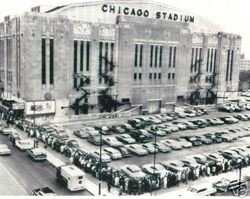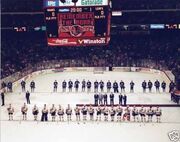Fanofpucks (talk | contribs) |
No edit summary |
||
| (One intermediate revision by the same user not shown) | |||
| Line 30: | Line 30: | ||
| dimensions = |
| dimensions = |
||
}} |
}} |
||
| − | The '''Chicago Stadium''' was an indoor sports arena in [[Chicago, Illinois]]. The Stadium hosted the [[Chicago Blackhawks]] of the [[National Hockey League|NHL]] from [[1929–30 NHL season|1929]]–[[1993–94 NHL season|1994]] |
+ | The '''Chicago Stadium''' was an indoor sports arena in [[Chicago, Illinois]]. The Stadium hosted the [[Chicago Blackhawks]] of the [[National Hockey League|NHL]] from [[1929–30 NHL season|1929]]–[[1993–94 NHL season|1994]] |
The stadium was first proposed by Chicago sports promoter Paddy Harmon. Harmon wanted to bring an NHL team to Chicago, but he lost out to Col. Frederic McLaughlin. This team would soon be known as the [[Chicago Blackhawks|Chicago Black Hawks]] (later 'Blackhawks'). Harmon then went on to at least try to get some control over the team by building a stadium for the Blackhawks to play in. He spent $2.5 million and borrowed more funds from friends, including James E. Norris in order to build the stadium. |
The stadium was first proposed by Chicago sports promoter Paddy Harmon. Harmon wanted to bring an NHL team to Chicago, but he lost out to Col. Frederic McLaughlin. This team would soon be known as the [[Chicago Blackhawks|Chicago Black Hawks]] (later 'Blackhawks'). Harmon then went on to at least try to get some control over the team by building a stadium for the Blackhawks to play in. He spent $2.5 million and borrowed more funds from friends, including James E. Norris in order to build the stadium. |
||
| Line 42: | Line 42: | ||
In addition to the close-quartered, triple-tiered, boxy layout of the building, much of the loud, ringing noise of the fans could be attributed to the fabled 3,663-pipe organ that was played during hockey games there, earning it the moniker of "The Madhouse on Madison (Street)". In the Stanley Cup semi-finals in 1971, when the Blackhawks scored a series-clinching empty-net goal, CBS TV announcer Dan Kelly reported, "I can feel our broadcast booth shaking! That's the kind of place Chicago Stadium is right now!" The dressing rooms at the Stadium were placed underneath the seats, and the cramped corridor that led to the ice, with its twenty-two steps, became the stuff of legend and hockey's version of cricket's famed Long Room. |
In addition to the close-quartered, triple-tiered, boxy layout of the building, much of the loud, ringing noise of the fans could be attributed to the fabled 3,663-pipe organ that was played during hockey games there, earning it the moniker of "The Madhouse on Madison (Street)". In the Stanley Cup semi-finals in 1971, when the Blackhawks scored a series-clinching empty-net goal, CBS TV announcer Dan Kelly reported, "I can feel our broadcast booth shaking! That's the kind of place Chicago Stadium is right now!" The dressing rooms at the Stadium were placed underneath the seats, and the cramped corridor that led to the ice, with its twenty-two steps, became the stuff of legend and hockey's version of cricket's famed Long Room. |
||
| − | It also became traditional for Blackhawk fans to cheer loudly throughout the singing of the Star Spangled Banner, especially when sung by Chicago favorite Wayne Messmer. |
+ | It also became traditional for Blackhawk fans to cheer loudly throughout the singing of the Star Spangled Banner, especially when sung by Chicago favorite Wayne Messmer. Denizens of the second balcony often added sparklers and flags to the occasion. Arguably, the most memorable of these was the singing before the [[42nd National Hockey League All-Star Game|1991 NHL All-Star Game]], which took place during the Gulf War. |
In 1992, Chicago Stadium was the center of the sports universe when both the Blackhawks and the Chicago Bulls reached the finals in their respective leagues. The Blackhawks got swept in [[1992 Stanley Cup Finals|their finals]] by the [[Pittsburgh Penguins]], while the Bulls won the 1992 NBA Finals. |
In 1992, Chicago Stadium was the center of the sports universe when both the Blackhawks and the Chicago Bulls reached the finals in their respective leagues. The Blackhawks got swept in [[1992 Stanley Cup Finals|their finals]] by the [[Pittsburgh Penguins]], while the Bulls won the 1992 NBA Finals. |
||
| Line 48: | Line 48: | ||
It was also the very last NHL-used facility to retain the use of an analog dial-type large four-sided clock for timekeeping in professional hockey games. That clock eventually was replaced by a four-sided scoreboard with a digital clock, and then by another, this one with a color electronic message board. |
It was also the very last NHL-used facility to retain the use of an analog dial-type large four-sided clock for timekeeping in professional hockey games. That clock eventually was replaced by a four-sided scoreboard with a digital clock, and then by another, this one with a color electronic message board. |
||
| − | The Stadium was also one of the last three NHL arenas (the others being [[Boston Garden]] and the [[Buffalo Memorial Auditorium]]) to have a shorter-than-regulation ice surface, as their construction predated the regulation. |
+ | The Stadium was also one of the last three NHL arenas (the others being [[Boston Garden]] and the [[Buffalo Memorial Auditorium]]) to have a shorter-than-regulation ice surface, as their construction predated the regulation. The distance was taken out of the neutral zone. |
==Demolition== |
==Demolition== |
||
| Line 81: | Line 81: | ||
{{Chicago Blackhawks}} |
{{Chicago Blackhawks}} |
||
[[Category:Chicago Blackhawks]] |
[[Category:Chicago Blackhawks]] |
||
| − | [[Category: |
+ | [[Category:NHL arena]] |
| + | [[Category:Former National Hockey League arena]] |
||
| + | [[Category:Indoor ice hockey venues in Illinois]] |
||
Latest revision as of 00:11, 19 November 2017

| The Chicago Stadium | |
|---|---|
| The Madhouse on Madison | |
| Location | 1800 W. Madison Street Chicago, Illinois 60612 |
| Opened | March 28, 1929 |
| Closed | 1994 |
| Demolished | 1995 |
| Owner | Arthur Wirtz |
| Tenants | Chicago Black Hawks (NHL) (1929-1994) |
| Capacity | 17,317 |
The Chicago Stadium was an indoor sports arena in Chicago, Illinois. The Stadium hosted the Chicago Blackhawks of the NHL from 1929–1994
The stadium was first proposed by Chicago sports promoter Paddy Harmon. Harmon wanted to bring an NHL team to Chicago, but he lost out to Col. Frederic McLaughlin. This team would soon be known as the Chicago Black Hawks (later 'Blackhawks'). Harmon then went on to at least try to get some control over the team by building a stadium for the Blackhawks to play in. He spent $2.5 million and borrowed more funds from friends, including James E. Norris in order to build the stadium.
Completed on March 28, 1929 at a cost of $9.5 million ($2.5 million was funded by Harmon), Chicago Stadium was the largest indoor arena in the world at the time - the closest to it in terms of capacity at the time was the third incarnation of New York's Madison Square Garden, which sat almost half as many people. Detroit's Olympia stadium, built two years earlier, was a model for the Chicago stadium and had a capacity of over 15,000 people. It was also the first arena with an air conditioning system (though the system was fairly rudimentary by modern standards, and was memorably given to filling the arena with fog during late-season games).
The Stadium sat 17,317 for hockey at the time of closure. Standees were allowed for many years, and often the official attendance figures in the published game summaries were given in round numbers, such as 18,500 or 20,000. The largest recorded crowd for an NHL game at the stadium was 20,069 for a playoff game between the Blackhawks and Minnesota North Stars on April 10, 1982. That record would be broken on April 23, 1996 when the Thunderdome, home of the Tampa Bay Lightning, would record an attendace of 28,183. That record was broken again for the 2003 Heritage Classic, and then the 2008 NHL Winter Classic at Ralph Wilson Stadium in Buffalo, NY.
"The Madhouse on Madison"
In addition to the close-quartered, triple-tiered, boxy layout of the building, much of the loud, ringing noise of the fans could be attributed to the fabled 3,663-pipe organ that was played during hockey games there, earning it the moniker of "The Madhouse on Madison (Street)". In the Stanley Cup semi-finals in 1971, when the Blackhawks scored a series-clinching empty-net goal, CBS TV announcer Dan Kelly reported, "I can feel our broadcast booth shaking! That's the kind of place Chicago Stadium is right now!" The dressing rooms at the Stadium were placed underneath the seats, and the cramped corridor that led to the ice, with its twenty-two steps, became the stuff of legend and hockey's version of cricket's famed Long Room.
It also became traditional for Blackhawk fans to cheer loudly throughout the singing of the Star Spangled Banner, especially when sung by Chicago favorite Wayne Messmer. Denizens of the second balcony often added sparklers and flags to the occasion. Arguably, the most memorable of these was the singing before the 1991 NHL All-Star Game, which took place during the Gulf War.
In 1992, Chicago Stadium was the center of the sports universe when both the Blackhawks and the Chicago Bulls reached the finals in their respective leagues. The Blackhawks got swept in their finals by the Pittsburgh Penguins, while the Bulls won the 1992 NBA Finals.
It was also the very last NHL-used facility to retain the use of an analog dial-type large four-sided clock for timekeeping in professional hockey games. That clock eventually was replaced by a four-sided scoreboard with a digital clock, and then by another, this one with a color electronic message board.
The Stadium was also one of the last three NHL arenas (the others being Boston Garden and the Buffalo Memorial Auditorium) to have a shorter-than-regulation ice surface, as their construction predated the regulation. The distance was taken out of the neutral zone.
Demolition
After the Blackhawks and Bulls moved to the United Center, the Chicago Stadium was demolished in 1995. CNN went so far as to televise the demolition, showing devoted Blackhawks and Bulls fans crying as the wrecking ball hit the old building.
- A plaque with the words "Chicago Stadium 1929–1994, remember the roar" is located behind a statue of the Blackhawks greatest players on the north side of the United Center.
- Two friezes from Chicago Stadium were incorporated into a building at St. Ignatius College Preparatory School, 1060 W. Roosevelt Road.

The last game played.
Notable events
- 1948, 1961, 1974 and 1991 - NHL All-Star Game
- 1994 - The final hockey game at Chicago Stadium was played on April 28. The Blackhawks lost to the Toronto Maple Leafs 1–0. eliminating them from the 1994 Stanley Cup Playoffs. The only goal in the game, and last goal ever scored, came from Mike Gartner in the first period.
External links
| Preceded by Chicago Coliseum |
Home of the Chicago Blackhawks 1929 – 1994 |
Succeeded by United Center |
| Preceded by Maple Leaf Gardens Montreal Forum Madison Square Garden Pittsburgh Civic Arena |
Host of the NHL All-Star Game 1948 1961 1974 1991 |
Succeeded by Maple Leaf Gardens Maple Leaf Gardens Montreal Forum Philadelphia Spectrum |
| Chicago Blackhawks | |
|---|---|
| Franchise • Players • Coaches • GMs • Seasons • Records • Draft Picks • United Center • Rockford IceHogs • Indy Fuel | |
